Blog
Possible Treatment of a Broken Toe
 Broken toes can happen for a variety of reasons. These include severely stubbed toes, enduring a stress fracture, or if a heavy object has been dropped on it. The noticeable symptoms often consist of sudden pain, swelling, and the affected toe may look crooked. Additionally, it may be difficult to walk normally, and wearing shoes may be uncomfortable. The toe may feel better when the foot is elevated, and this may help to reduce any existing swelling. Many toe fractures can be treated by taping the toe to the one next to it. This is referred to as buddy taping. If you experience any tingling or have an open wound on the toe, it is advised to counsel with a podiatrist who can properly treat broken toes.
Broken toes can happen for a variety of reasons. These include severely stubbed toes, enduring a stress fracture, or if a heavy object has been dropped on it. The noticeable symptoms often consist of sudden pain, swelling, and the affected toe may look crooked. Additionally, it may be difficult to walk normally, and wearing shoes may be uncomfortable. The toe may feel better when the foot is elevated, and this may help to reduce any existing swelling. Many toe fractures can be treated by taping the toe to the one next to it. This is referred to as buddy taping. If you experience any tingling or have an open wound on the toe, it is advised to counsel with a podiatrist who can properly treat broken toes.
Broken toes may cause a lot of pain and should be treated as soon as possible. If you have any concerns about your feet, contact one of our podiatrists from Westside Podiatry Center, LLP. Our doctors will treat your foot and ankle needs.
What Is a Broken Toe?
A broken toe occurs when one or more of the toe bones of the foot are broken after an injury. Injuries such as stubbing your toe or dropping a heavy object on it may cause a toe fracture.
Symptoms of a Broken Toe
- Swelling
- Pain (with/without wearing shoes)
- Stiffness
- Nail Injury
Although the injured toe should be monitored daily, it is especially important to have a podiatrist look at your toe if you have severe symptoms. Some of these symptoms include worsening or new pain that is not relieved with medication, sores, redness, or open wounds near the toe.
If you have any questions, please feel free to contact one of our offices located in Liverpool, Camillus, Skaneateles, Oswego, and Cicero, NY . We offer the newest diagnostic and treatment technologies for all your foot care needs.
Read more about What to Know About a Broken ToePossible Foot Pain May Come from Wearing Flip-Flops
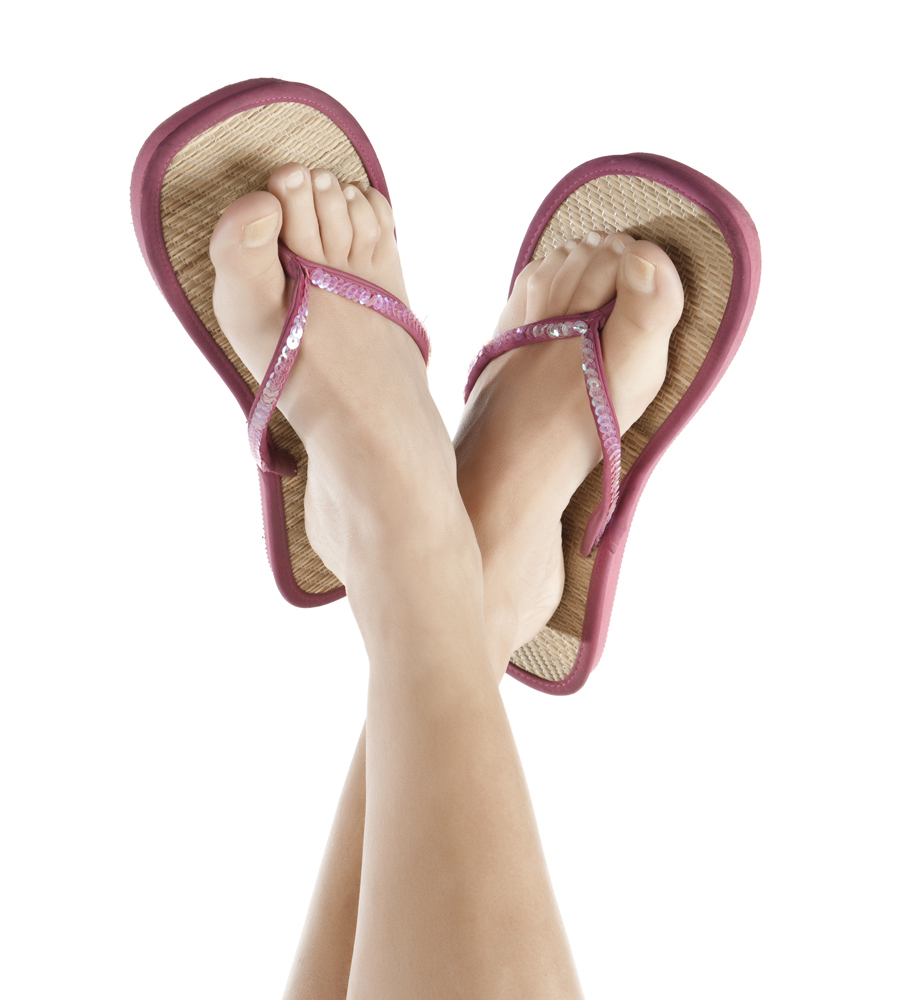 Flip-flops are a popular shoe to wear during the summer months, despite the damage that may occur to your feet. It is a natural reaction to clench your toes to help keep the shoe on the foot, and this may gradually change the way you walk. The muscles in the feet and calves may be affected, and this can lead to having sharp pains in the heel. Research has indicated that it may be acceptable to wear flip-flops occasionally, and this may limit any potential damage the feet may receive. If you generally walk for long distances, it is best to wear a sandal that has a strap on the back to help keep the shoe on the foot. If you would like additional information on how flip-flops may affect the feet, speak to a podiatrist who can answer any questions you may have.
Flip-flops are a popular shoe to wear during the summer months, despite the damage that may occur to your feet. It is a natural reaction to clench your toes to help keep the shoe on the foot, and this may gradually change the way you walk. The muscles in the feet and calves may be affected, and this can lead to having sharp pains in the heel. Research has indicated that it may be acceptable to wear flip-flops occasionally, and this may limit any potential damage the feet may receive. If you generally walk for long distances, it is best to wear a sandal that has a strap on the back to help keep the shoe on the foot. If you would like additional information on how flip-flops may affect the feet, speak to a podiatrist who can answer any questions you may have.
Flip-flops can cause a lot of problems for your feet. If you have any concerns about your feet or ankles, contact one of our podiatrists from Westside Podiatry Center, LLP. Our doctors will assist you with all of your foot and ankle needs.
Flip-Flops and Feet
Flip-flops have managed to become a summer essential for a lot of people. While the shoes may be stylish and easy to slip on and off, they can be dangerous to those who wear them too often. These shoes might protect you from fungal infections such as athlete’s foot, but they can also give you foot pain and sprained ankles if you trip while wearing them.
When Are They Okay to Wear?
Flip-flops should only be worn for very short periods of time. They can help protect your feet in places that are crawling with fungi, such as gym locker rooms. Athlete’s foot and plantar warts are two common fungi that flip-flops may help protect your feet against.
Why Are They Bad for My Feet?
These shoes do not offer any arch support, so they are not ideal for everyday use. They also do not provide shock absorption or heel cushioning which can be problematic for your feet. Additionally, you may suffer from glass cuts, puncture wounds, and stubbed toes since they offer little protection for your feet.
More Reasons Why They Are Bad for Your Feet
- They Slow You Down
- May Cause Blisters and Calluses
- Expose Your Feet to Bacteria
If you have any questions, please feel free to contact one of our offices located in Liverpool, Camillus, Skaneateles, Oswego, and Cicero, NY . We offer the newest diagnostic and treatment technologies for all your foot care needs.
Read more about Flipping Out About Flip FlopsPregnancy and Foot Health
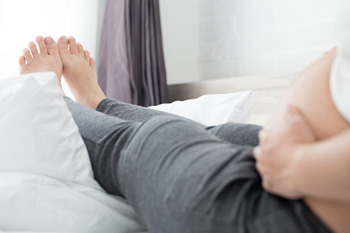 Foot problems are a common complication associated with pregnancy, due to the extra weight and pressure that the feet endure. Three of the most common foot issues that occur during pregnancy are swollen feet, arch pain, and ingrown toenails. Throbbing and swollen feet can be a result of excess fluid buildup. Stretching, wearing wide comfortable shoes, and elevating your feet can help to reduce swelling. Additional weight on the feet during pregnancy can cause the arches to begin to flatten, which may then lead to arch pain. Stretches can also help to alleviate some of the pressure on the arch and help reduce pain. Since most women experience an increase in foot size during pregnancy, it is important to wear wider shoes. If the foot is cramped inside of a shoe that is too tight, this can easily lead to ingrown toenails, which are inconvenient and uncomfortable. If you would like additional information on how to care for your feet while pregnant, then it is recommended you speak with podiatrist.
Foot problems are a common complication associated with pregnancy, due to the extra weight and pressure that the feet endure. Three of the most common foot issues that occur during pregnancy are swollen feet, arch pain, and ingrown toenails. Throbbing and swollen feet can be a result of excess fluid buildup. Stretching, wearing wide comfortable shoes, and elevating your feet can help to reduce swelling. Additional weight on the feet during pregnancy can cause the arches to begin to flatten, which may then lead to arch pain. Stretches can also help to alleviate some of the pressure on the arch and help reduce pain. Since most women experience an increase in foot size during pregnancy, it is important to wear wider shoes. If the foot is cramped inside of a shoe that is too tight, this can easily lead to ingrown toenails, which are inconvenient and uncomfortable. If you would like additional information on how to care for your feet while pregnant, then it is recommended you speak with podiatrist.
Pregnant women with swollen feet can be treated with a variety of different methods that are readily available. For more information about other cures for swollen feet during pregnancy, consult with one of our podiatrists from Westside Podiatry Center, LLP. Our doctors will attend to all of your foot and ankle needs.
What Foot Problems Can Arise During Pregnancy?
One problem that can occur is overpronation, which occurs when the arch of the foot flattens and tends to roll inward. This can cause pain and discomfort in your heels while you’re walking or even just standing up, trying to support your baby.
Another problem is edema, or swelling in the extremities. This often affects the feet during pregnancy but tends to occur in the later stages.
How Can I Keep My Feet Healthy During Pregnancy?
- Wearing orthotics can provide extra support for the feet and help distribute weight evenly
- Minimize the amount of time spent walking barefoot
- Wear shoes with good arch support
- Wear shoes that allow for good circulation to the feet
- Elevate feet if you experience swelling
- Massage your feet
- Get regular, light exercise, such as walking, to promote blood circulation to the feet
If you have any questions please feel free to contact one of our offices located in Liverpool, Camillus, Skaneateles, Oswego, and Cicero, NY . We offer the newest diagnostic and treatment technologies for all your foot and ankle needs.
Read more about Foot Care for Pregnant WomenDo You Wanna Be a Podiatrist?
 People who are interested in helping folks who have foot and ankle disorders may want to consider podiatry as a career choice. Some of the conditions that are treated may be ingrown toenails, chronic foot pain, or bunions, which may require surgery for permanent relief. Additionally, podiatrists may specialize in diabetic foot care, and can prescribe custom-made orthotics. The schooling that is required in most states is a four year post graduate program followed by three years of residency training. If you would like to pursue a career in podiatric medicine, speak with a podiatrist who can answer any questions you may have.
People who are interested in helping folks who have foot and ankle disorders may want to consider podiatry as a career choice. Some of the conditions that are treated may be ingrown toenails, chronic foot pain, or bunions, which may require surgery for permanent relief. Additionally, podiatrists may specialize in diabetic foot care, and can prescribe custom-made orthotics. The schooling that is required in most states is a four year post graduate program followed by three years of residency training. If you would like to pursue a career in podiatric medicine, speak with a podiatrist who can answer any questions you may have.
If you are dealing with pain in your feet and ankles, you may want to seek help from a podiatrist. Feel free to contact one of our podiatrists from Westside Podiatry Center, LLP. Our doctors can provide the care you need to keep you pain-free and on your feet.
What Is a Podiatrist?
A podiatrist is a doctor of podiatric medicine who diagnoses and treats conditions of the foot, ankle, and related structures of the leg. Your podiatrist may specialize in a certain field such as sports medicine, wound care, pediatrics, and diabetic care. Podiatrists have the ability to become board certified through training, clinical experience, and then taking an exam.
What Do Podiatrists Do?
On a daily basis, a podiatrist may perform the following activities:
- Diagnose foot ailments such as ulcers, tumors, fractures, etc.
- Use innovative methods to treat conditions
- Use corrective orthotics, casts, and strappings to correct deformities
- Correct walking patterns and balance
- Provide individual consultations to patients
It is very important that you take care of your feet. It’s easy to take having healthy feet for granted, however foot problems tend to be among the most common health conditions. Podiatrists can help diagnose and treat a variety of feet related conditions, so it is crucial that you visit one if you need assistance.
If you have any questions please feel free to contact one of our offices located in Liverpool, Camillus, Skaneateles, Oswego, and Cicero, NY . We offer the newest diagnostic and treatment technologies for all your foot and ankle needs.
Read more about What is a Podiatrist?
Understanding Morton’s Neuroma
 Morton’s neuroma, also known as Morton’s metatarsalgia, is caused by the irritation or thickening of a nerve in the foot. The irritation of this nerve causes pain in between toes or on the ball of the foot. In extreme cases, the pain can sometimes affect mobility and is most commonly felt between the third and fourth toes. The symptoms usually begin as a tingling feeling that gradually escalates to sharp, shooting, or burning pain. When pressure is put on the foot, pain or discomfort usually increases. Physical activities and wearing tight-fitting shoes can therefore worsen symptoms. It is best to let an afflicted foot rest if symptoms occur, because rest and proper footwear can help ease the pain. If you believe you have Morton’s neuroma or have similar symptoms, speak with your podiatrist to learn about treatment options.
Morton’s neuroma, also known as Morton’s metatarsalgia, is caused by the irritation or thickening of a nerve in the foot. The irritation of this nerve causes pain in between toes or on the ball of the foot. In extreme cases, the pain can sometimes affect mobility and is most commonly felt between the third and fourth toes. The symptoms usually begin as a tingling feeling that gradually escalates to sharp, shooting, or burning pain. When pressure is put on the foot, pain or discomfort usually increases. Physical activities and wearing tight-fitting shoes can therefore worsen symptoms. It is best to let an afflicted foot rest if symptoms occur, because rest and proper footwear can help ease the pain. If you believe you have Morton’s neuroma or have similar symptoms, speak with your podiatrist to learn about treatment options.
Morton’s neuroma is a very uncomfortable condition to live with. If you think you have Morton’s neuroma, contact one of our podiatrists of Westside Podiatry Center, LLP. Our doctors will attend to all of your foot care needs and answer any of your related questions.
Morton’s Neuroma
Morton's neuroma is a painful foot condition that commonly affects the areas between the second and third or third and fourth toe, although other areas of the foot are also susceptible. Morton’s neuroma is caused by an inflamed nerve in the foot that is being squeezed and aggravated by surrounding bones.
What Increases the Chances of Having Morton’s Neuroma?
- Ill-fitting high heels or shoes that add pressure to the toe or foot
- Jogging, running or any sport that involves constant impact to the foot
- Flat feet, bunions, and any other foot deformities
Morton’s neuroma is a very treatable condition. Orthotics and shoe inserts can often be used to alleviate the pain on the forefront of the feet. In more severe cases, corticosteroids can also be prescribed. In order to figure out the best treatment for your neuroma, it’s recommended to seek the care of a podiatrist who can diagnose your condition and provide different treatment options.
If you have any questions, please feel free to contact one of our offices located in Liverpool, Camillus, Skaneateles, Oswego, and Cicero, NY . We offer the newest diagnostic and treatment technologies for all your foot care needs.
Read more about Morton's NeuromaShould Young Children Walk Barefoot?
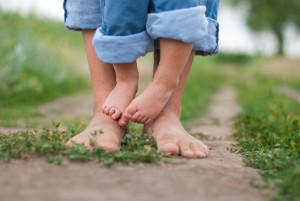 Research has shown that it may not be necessary for young toddlers to wear shoes while they are walking indoors. When they are able to walk barefoot, their toes will naturally develop a grasping action, which may help the feet to grow normally. When shoes are eventually purchased, it is important to properly measure your child’s foot to determine the correct shoe size. This should be done every four months for children under the age of five, and every six months for older children. Many babies are born with flat feet and may remain that way until the arch develops at approximately six years of age. If you notice abnormal walking patterns in your child, it is advised to speak to a podiatrist who can guide you toward foot care that is right for your child.
Research has shown that it may not be necessary for young toddlers to wear shoes while they are walking indoors. When they are able to walk barefoot, their toes will naturally develop a grasping action, which may help the feet to grow normally. When shoes are eventually purchased, it is important to properly measure your child’s foot to determine the correct shoe size. This should be done every four months for children under the age of five, and every six months for older children. Many babies are born with flat feet and may remain that way until the arch develops at approximately six years of age. If you notice abnormal walking patterns in your child, it is advised to speak to a podiatrist who can guide you toward foot care that is right for your child.
Making sure that your children maintain good foot health is very important as they grow. If you have any questions, contact one of our podiatrists of Westside Podiatry Center, LLP. Our doctors can provide the care you need to keep you pain-free and on your feet.
Keeping Children's Feet Healthy
Having healthy feet during childhood can help prevent medical problems later in life, namely in the back and legs. As children grow, their feet require different types of care. Here are some things to consider...
Although babies do not walk yet, it is still very important to take care of their feet.
Avoid putting tight shoes or socks on his or her feet.
Allow the baby to stretch and kick his or her feet to feel comfortable.
As a toddler, kids are now on the move and begin to develop differently. At this age, toddlers are getting a feel for walking, so don’t be alarmed if your toddler is unsteady or ‘walks funny’.
As your child gets older, it is important to teach them how to take care of their feet.
Show them proper hygiene to prevent infections such as fungus.
Be watchful for any pain or injury.
Have all injuries checked by a doctor as soon as possible.
Comfortable, protective shoes should always be worn, especially at play.
If you have any questions please feel free to contact one of our offices located in Liverpool, Camillus, Skaneateles, Oswego, and Cicero, NY . We offer the newest diagnostic and treatment technologies for all your foot and ankle needs.
Read more about How to Care for Your Child's FeetWhy Does My Child Have Flat Feet?
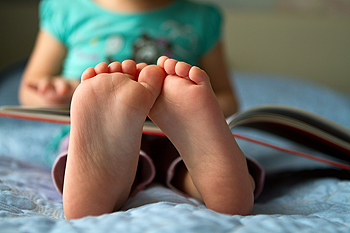 A child’s foot will typically change shape as the aging process occurs. Most babies are born with flat feet, and the arch will be fully developed at approximately eighteen years of age. When children begin to walk, their feet may become less flexible as the bones become stronger. Research has indicated that it may be beneficial for young children to walk barefoot indoors as often as possible. This may help the feet to develop adequate muscle tone and strength. It is important to wear shoes while walking outdoors, and this may aid in protecting the soles of the feet. After the correct size is determined by properly measuring the feet, the first pair of shoes can be purchased. They should consist of adequate cushioning that will provide maximum stability. Additionally, if the shoes are made of a breathable material, they may provide the flexibility that is needed to easily walk. If you have questions about your children’s feet, please speak to a podiatrist who can answer any questions you may have.
A child’s foot will typically change shape as the aging process occurs. Most babies are born with flat feet, and the arch will be fully developed at approximately eighteen years of age. When children begin to walk, their feet may become less flexible as the bones become stronger. Research has indicated that it may be beneficial for young children to walk barefoot indoors as often as possible. This may help the feet to develop adequate muscle tone and strength. It is important to wear shoes while walking outdoors, and this may aid in protecting the soles of the feet. After the correct size is determined by properly measuring the feet, the first pair of shoes can be purchased. They should consist of adequate cushioning that will provide maximum stability. Additionally, if the shoes are made of a breathable material, they may provide the flexibility that is needed to easily walk. If you have questions about your children’s feet, please speak to a podiatrist who can answer any questions you may have.
The health of a child’s feet is vital to their overall well-being. If you have any questions regarding foot health, contact one of our podiatrists of Westside Podiatry Center, LLP. Our doctors can provide the care you need to keep you pain-free and on your feet.
Tips for Keeping Children's Feet Healthy
- Make sure their shoes fit properly
- Look for any signs of in-toeing or out-toeing
- Check to see if they have Clubfoot (condition that affects your child’s foot and ankle, twisting the heel and toes inward) which is one of the most common nonmajor birth defects.
- Lightly cover your baby’s feet (Tight covers may keep your baby from moving their feet freely, and could prevent normal development)
- Allow your toddler to go shoeless (Shoes can be restricting for a young child’s foot)
- Cut toenails straight across to avoid ingrown toenails
- Keep your child’s foot clean and dry
- Cover cuts and scrapes. Wash any scratches with soap and water and cover them with a bandage until they’ve healed.
If you have any questions, please feel free to contact one of our offices located in Liverpool, Camillus, Skaneateles, Oswego, and Cicero, NY . We offer the newest diagnostic and treatment technologies for all your foot care needs.
Read more about What to Do to Keep Your Child’s Feet HealthyDaily Foot Care Is Essential for Diabetic Patients
 Research has shown the importance of taking care of your feet, and this is especially true if you are a diabetic patient. Many diabetic people have neuropathy, and this may cause a lack of feeling in the feet. Small cuts or bruises may go unnoticed as a result of this condition and may take longer to heal. Foot ulcers may affect up to twenty-five percent of diabetic patients, and it is important to properly take care of your feet. This can be accomplished by checking the feet daily, which may help you to notice any blisters, ingrown toenails, cuts or swelling that may exist. Additionally, the feet should be washed in lukewarm water on a daily basis, gently dried, and followed by using a good moisturizer. This may help to keep the skin soft, which may prevent dry skin. Wearing shoes that fit properly will help the overall health of the feet and choosing seamless socks may aid in preventing cuts in the skin. If you have diabetes, it is strongly suggested that you should seek the counsel of a podiatrist who can properly guide you in learning how to take care of diabetic feet.
Research has shown the importance of taking care of your feet, and this is especially true if you are a diabetic patient. Many diabetic people have neuropathy, and this may cause a lack of feeling in the feet. Small cuts or bruises may go unnoticed as a result of this condition and may take longer to heal. Foot ulcers may affect up to twenty-five percent of diabetic patients, and it is important to properly take care of your feet. This can be accomplished by checking the feet daily, which may help you to notice any blisters, ingrown toenails, cuts or swelling that may exist. Additionally, the feet should be washed in lukewarm water on a daily basis, gently dried, and followed by using a good moisturizer. This may help to keep the skin soft, which may prevent dry skin. Wearing shoes that fit properly will help the overall health of the feet and choosing seamless socks may aid in preventing cuts in the skin. If you have diabetes, it is strongly suggested that you should seek the counsel of a podiatrist who can properly guide you in learning how to take care of diabetic feet.
Diabetic foot care is important in preventing foot ailments such as ulcers. If you are suffering from diabetes or have any other concerns about your feet, contact one of our podiatrists from Westside Podiatry Center, LLP. Our doctors can provide the care you need to keep you pain-free and on your feet.
Diabetic Foot Care
Diabetes affects millions of people every year. The condition can damage blood vessels in many parts of the body, especially the feet. Because of this, taking care of your feet is essential if you have diabetes, and having a podiatrist help monitor your foot health is highly recommended.
The Importance of Caring for Your Feet
- Routinely inspect your feet for bruises or sores.
- Wear socks that fit your feet comfortably.
- Wear comfortable shoes that provide adequate support.
Patients with diabetes should have their doctor monitor their blood levels, as blood sugar levels play such a huge role in diabetic care. Monitoring these levels on a regular basis is highly advised.
It is always best to inform your healthcare professional of any concerns you may have regarding your feet, especially for diabetic patients. Early treatment and routine foot examinations are keys to maintaining proper health, especially because severe complications can arise if proper treatment is not applied.
If you have any questions please feel free to contact one of our offices located in Liverpool, Camillus, Skaneateles, Oswego, and Cicero, NY . We offer the newest diagnostic and treatment technologies for all your foot and ankle needs.
Read more about Diabetic Foot ConditionsSymptoms of Sever’s Disease
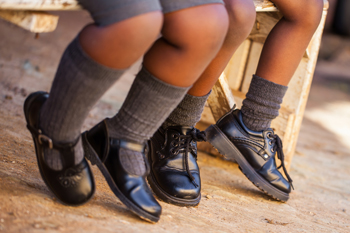 The condition that is referred to as Sever’s disease will typically affect young teenagers. Noticeable symptoms may include inflammation and swelling in the heel, and this may be a result of an injury that may have occurred to the growth plate. Patients who are afflicted with this condition may notice they are walking on tip toes or limping, and their feet may feel stiff when they are waking up. It typically affects older children who frequently participate in sporting activities. This may cause the tendons and muscles to tighten, and pressure may be put on the growth plate. Mild relief may be found if the activities are stopped that may have caused this condition. Additionally, some patients find it helpful to wear shoes that have an open back, or to wrap the heel with an elastic bandage. If you think your child may have Sever’s disease, it is advised to consult with a podiatrist who can properly treat this condition.
The condition that is referred to as Sever’s disease will typically affect young teenagers. Noticeable symptoms may include inflammation and swelling in the heel, and this may be a result of an injury that may have occurred to the growth plate. Patients who are afflicted with this condition may notice they are walking on tip toes or limping, and their feet may feel stiff when they are waking up. It typically affects older children who frequently participate in sporting activities. This may cause the tendons and muscles to tighten, and pressure may be put on the growth plate. Mild relief may be found if the activities are stopped that may have caused this condition. Additionally, some patients find it helpful to wear shoes that have an open back, or to wrap the heel with an elastic bandage. If you think your child may have Sever’s disease, it is advised to consult with a podiatrist who can properly treat this condition.
Sever's disease often occurs in children and teens. If your child is experiencing foot or ankle pain, see one of our podiatrists from Westside Podiatry Center, LLP. Our doctors can treat your child’s foot and ankle needs.
Sever’s Disease
Sever’s disease is also known as calcaneal apophysitis, which is a medical condition that causes heel pain I none or both feet. The disease is known to affect children between the ages of 8 and 14.
Sever’s disease occurs when part of the child’s heel known as the growth plate (calcaneal epiphysis) is attached to the Achilles tendon. This area can suffer injury when the muscles and tendons of the growing foot do not keep pace with bone growth. Therefore, the constant pain which one experiences at the back of the heel will make the child unable to put any weight on the heel. The child is then forced to walk on their toes.
Symptoms
Acute pain – Pain associated with Sever’s disease is usually felt in the heel when the child engages in physical activity such as walking, jumping and or running.
Highly active – Children who are very active are among the most susceptible in experiencing Sever’s disease, because of the stress and tension placed on their feet.
If you have any questions, please feel free to contact one of our offices located in Liverpool, Camillus, Skaneateles, Oswego, and Cicero, NY . We offer the newest diagnostic and treatment technologies for all your foot and ankle injuries.
Read more about Sever's DiseaseCan Gout Be Prevented?
 The medical term referred to as gout will typically affect the big toe and surrounding areas. Typical symptoms may generally include severe pain and discomfort in the area of the big toe, heat that may radiate from the foot, in addition to swelling and redness. It occurs as a result of elevated uric acid levels in the blood, which causes crystals to form in the joints. There may be several reasons for this to happen, including diabetes, high blood pressure, or congestive heart failure. Additionally, eating foods that have elevated fructose levels may lead to the onset of gout, in addition to drinking excess alcohol, or eating red meat or seafood. Successful prevention and treatment of gout may begin with eating healthy foods and implementing a gentle exercise program. If obesity exists, it may be helpful to lose excess weight which may aid in protecting the joints. If you are having gout attacks, it is advised to speak to a podiatrist who can properly treat this condition.
The medical term referred to as gout will typically affect the big toe and surrounding areas. Typical symptoms may generally include severe pain and discomfort in the area of the big toe, heat that may radiate from the foot, in addition to swelling and redness. It occurs as a result of elevated uric acid levels in the blood, which causes crystals to form in the joints. There may be several reasons for this to happen, including diabetes, high blood pressure, or congestive heart failure. Additionally, eating foods that have elevated fructose levels may lead to the onset of gout, in addition to drinking excess alcohol, or eating red meat or seafood. Successful prevention and treatment of gout may begin with eating healthy foods and implementing a gentle exercise program. If obesity exists, it may be helpful to lose excess weight which may aid in protecting the joints. If you are having gout attacks, it is advised to speak to a podiatrist who can properly treat this condition.
Gout is a foot condition that requires certain treatment and care. If you are seeking treatment, contact one of our podiatrists from Westside Podiatry Center, LLP. Our doctors will treat your foot and ankle needs.
What Is Gout?
Gout is a type of arthritis caused by a buildup of uric acid in the bloodstream. It often develops in the foot, especially the big toe area, although it can manifest in other parts of the body as well. Gout can make walking and standing very painful and is especially common in diabetics and the obese.
People typically get gout because of a poor diet. Genetic predisposition is also a factor. The children of parents who have had gout frequently have a chance of developing it themselves.
Gout can easily be identified by redness and inflammation of the big toe and the surrounding areas of the foot. Other symptoms include extreme fatigue, joint pain, and running high fevers. Sometimes corticosteroid drugs can be prescribed to treat gout, but the best way to combat this disease is to get more exercise and eat a better diet.
If you have any questions please feel free to contact one of our offices located in Liverpool, Camillus, Skaneateles, Oswego, and Cicero, NY . We offer the newest diagnostic and treatment technologies for all your foot and ankle needs.
Read more about GoutMore...
The Importance of Resting a Sprained Ankle
 If you have fallen or twisted your foot, you may have sprained your ankle. If you are aware of the importance of treating this condition early, the recovery process may be accelerated. Resting the ankle can be accomplished by not walking on it. Using crutches may be beneficial in eliminating the pressure from the affected joints. Additionally, elevating the foot may reduce any swelling that may be present. A diagnosis may be necessary in determining the severity of the sprain, and if there has been damage done to the tendons and ligaments. For severe sprains, a rehabilitation program may be needed which may be helpful in regaining total mobility of the ankle. If you have sprained your ankle, please consult with a podiatrist as quickly as possible, so the correct treatment can begin.
If you have fallen or twisted your foot, you may have sprained your ankle. If you are aware of the importance of treating this condition early, the recovery process may be accelerated. Resting the ankle can be accomplished by not walking on it. Using crutches may be beneficial in eliminating the pressure from the affected joints. Additionally, elevating the foot may reduce any swelling that may be present. A diagnosis may be necessary in determining the severity of the sprain, and if there has been damage done to the tendons and ligaments. For severe sprains, a rehabilitation program may be needed which may be helpful in regaining total mobility of the ankle. If you have sprained your ankle, please consult with a podiatrist as quickly as possible, so the correct treatment can begin.
Ankle sprains are common but need immediate attention. If you need your feet checked, contact one of our podiatrists from Westside Podiatry Center, LLP. Our doctors can provide the care you need to keep you pain-free and on your feet.
How Does an Ankle Sprain Occur?
Ankle sprains take place when the ligaments in your ankle are torn or stretched beyond their limits. There are multiple ways that the ankle can become injured, including twisting or rolling over onto your ankle, putting undue stress on it, or causing trauma to the ankle itself.
What Are the Symptoms?
- Mild to moderate bruising
- Limited mobility
- Swelling
- Discoloration of the skin (depending on severity)
Preventing a Sprain
- Wearing appropriate shoes for the occasion
- Stretching before exercises and sports
- Knowing your limits
Treatment of a Sprain
Treatment of a sprain depends on the severity. Many times, people are told to rest and remain off their feet completely, while others are given an air cast. If the sprain is very severe, surgery may be required.
If you have suffered an ankle sprain previously, you may want to consider additional support such as a brace and regular exercises to strengthen the ankle.
If you have any questions please feel free to contact one of our offices located in Liverpool, Camillus, Skaneateles, Oswego, and Cicero, NY . We offer the newest diagnostic and treatment technologies for all your foot and ankle needs.
Read more about Ankle SprainsPlantar Warts and Home Remedies
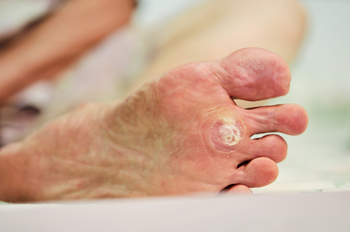 Plantar warts are an uncomfortable condition that affects the soles of the feet. Unlike other warts, plantar warts grow inward through the thick skin on the bottom of the foot. This can cause extreme discomfort and sensitivity. Many people try to fix their plantar warts at home through various methods, including apple cider vinegar, duct tape, and even urine. There is no scientific evidence to support that these remedies actually work, but sometimes they might trigger the immune system. Plantar warts hide in the thick skin on the sole of the foot and usually go undetected by the immune system, which helps them thrive. If attention is brought to them, then the immune system might be able to fight off the infection, but the most effective way to fix plantar warts is to seek help from a medical professional. If you think you may have plantar warts, then it is suggested you speak with a podiatrist to receive the proper treatment.
Plantar warts are an uncomfortable condition that affects the soles of the feet. Unlike other warts, plantar warts grow inward through the thick skin on the bottom of the foot. This can cause extreme discomfort and sensitivity. Many people try to fix their plantar warts at home through various methods, including apple cider vinegar, duct tape, and even urine. There is no scientific evidence to support that these remedies actually work, but sometimes they might trigger the immune system. Plantar warts hide in the thick skin on the sole of the foot and usually go undetected by the immune system, which helps them thrive. If attention is brought to them, then the immune system might be able to fight off the infection, but the most effective way to fix plantar warts is to seek help from a medical professional. If you think you may have plantar warts, then it is suggested you speak with a podiatrist to receive the proper treatment.
Plantar warts can be very uncomfortable. If you need your feet checked, contact one of our podiatrists from Westside Podiatry Center, LLP. Our doctors will assist you with all of your foot and ankle needs.
About Plantar Warts
Plantar warts are the result of HPV, or human papillomavirus, getting into open wounds on the feet. They are mostly found on the heels or balls of the feet.
While plantar warts are generally harmless, those experiencing excessive pain or those suffering from diabetes or a compromised immune system require immediate medical care. Plantar warts are easily diagnosed, usually through scraping off a bit of rough skin or by getting a biopsy.
Symptoms
- Lesions on the bottom of your feet, usually rough and grainy
- Hard or thick callused spots
- Wart seeds, which are small clotted blood vessels that look like little black spots
- Pain, discomfort, or tenderness of your feet when walking or standing
Treatment
- Freezing
- Electric tool removal
- Laser Treatment
- Topical Creams (prescription only)
- Over-the-counter medications
To help prevent developing plantar warts, avoid walking barefoot over abrasive surfaces that can cause cuts or wounds for HPV to get into. Avoiding direct contact with other warts, as well as not picking or rubbing existing warts, can help prevent the further spread of plantar warts. However, if you think you have developed plantar warts, speak to your podiatrist. He or she can diagnose the warts on your feet and recommend the appropriate treatment options.
If you have any questions please feel free to contact one of our offices located in Liverpool, Camillus, Skaneateles, Oswego, and Cicero, NY . We offer the newest diagnostic and treatment technologies for all your foot and ankle needs.
Read more about Plantar WartsWhat Causes Flat Feet
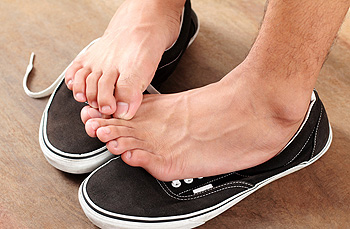 Flat feet, also known as fallen arches, is a condition that occurs when the arch of the foot is lower than usual. Normally, the foot has an arch in the middle, so the heel and ball of the foot are primarily what touches the ground. For those with flat feet, the arch may have never fully developed, or over time might have flattened downward. Children’s feet develop differently, and some children never develop an arch. This is nothing to be too concerned about and usually results in little to no complications. On the other end of the spectrum, some flat feet develop over time as a result of wear and tear. Adults who have injured their foot or ankle, have rheumatoid arthritis, have diabetes, or are obese are at a higher risk for their arch to drop. While this condition usually does not cause serious health issues, if you think you have flat feet or may be developing it, then it is recommended you speak with a podiatrist to gain further knowledge.
Flat feet, also known as fallen arches, is a condition that occurs when the arch of the foot is lower than usual. Normally, the foot has an arch in the middle, so the heel and ball of the foot are primarily what touches the ground. For those with flat feet, the arch may have never fully developed, or over time might have flattened downward. Children’s feet develop differently, and some children never develop an arch. This is nothing to be too concerned about and usually results in little to no complications. On the other end of the spectrum, some flat feet develop over time as a result of wear and tear. Adults who have injured their foot or ankle, have rheumatoid arthritis, have diabetes, or are obese are at a higher risk for their arch to drop. While this condition usually does not cause serious health issues, if you think you have flat feet or may be developing it, then it is recommended you speak with a podiatrist to gain further knowledge.
Flatfoot is a condition many people suffer from. If you have flat feet, contact one of our podiatrists from Westside Podiatry Center, LLP. Our doctors will treat your foot and ankle needs.
What Are Flat Feet?
Flatfoot is a condition in which the arch of the foot is depressed and the sole of the foot is almost completely in contact with the ground. About 20-30% of the population generally has flat feet because their arches never formed during growth.
Conditions & Problems:
Having flat feet makes it difficult to run or walk because of the stress placed on the ankles.
Alignment – The general alignment of your legs can be disrupted, because the ankles move inward which can cause major discomfort.
Knees – If you have complications with your knees, flat feet can be a contributor to arthritis in that area.
Symptoms
- Pain around the heel or arch area
- Trouble standing on the tip toe
- Swelling around the inside of the ankle
- Flat look to one or both feet
- Having your shoes feel uneven when worn
Treatment
If you are experiencing pain and stress on the foot you may weaken the posterior tibial tendon, which runs around the inside of the ankle.
If you have any questions please feel free to contact one of our offices located in Liverpool, Camillus, Skaneateles, Oswego, and Cicero, NY . We offer the newest diagnostic and treatment technologies for all your foot and ankle needs.
Read more about FlatfootShould You Pop Your Blister?
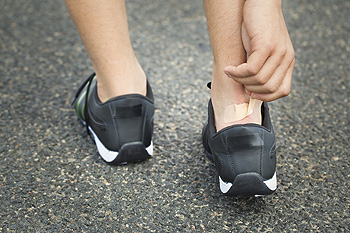 Blisters usually form on the back of the ankle and are a result of friction between your skin and your shoe. Depending on what caused the blister, blisters can be filled with a couple different fluids. These fluids include, plasma, blood, serum, and pus. These fluids are working to protect the skin and assist the body in the healing process. This is why you should never pop or break a blister, doing so will only stall the healing process. Also, opening up the blister and creating a wound puts you at a higher risk for infection. There are some instances when the blister should be drained, but this should be done by a medical professional. A doctor can use a sterile needle to drain the fluid and this is a much safer method. If you have a blister and think that it should be drained, then it is suggested you speak to a podiatrist in order to properly take care of it.
Blisters usually form on the back of the ankle and are a result of friction between your skin and your shoe. Depending on what caused the blister, blisters can be filled with a couple different fluids. These fluids include, plasma, blood, serum, and pus. These fluids are working to protect the skin and assist the body in the healing process. This is why you should never pop or break a blister, doing so will only stall the healing process. Also, opening up the blister and creating a wound puts you at a higher risk for infection. There are some instances when the blister should be drained, but this should be done by a medical professional. A doctor can use a sterile needle to drain the fluid and this is a much safer method. If you have a blister and think that it should be drained, then it is suggested you speak to a podiatrist in order to properly take care of it.
Blisters are prone to making everyday activities extremely uncomfortable. If your feet are hurting, contact one of our podiatrists of Westside Podiatry Center, LLP. Our doctors can provide the care you need to keep you pain-free and on your feet.
Foot Blisters
Foot blisters develop as a result of constantly wearing tight or ill-fitting footwear. This happens due to the constant rubbing from the shoe, which can often lead to pain.
What Are Foot Blisters?
A foot blister is a small fluid-filled pocket that forms on the upper-most layer of the skin. Blisters are filled with clear fluid and can lead to blood drainage or pus if the area becomes infected.
How Do Blisters Form?
Blisters on the feet are often the result of constant friction of skin and material, usually by shoe rubbing. Walking in sandals, boots, or shoes that don’t fit properly for long periods of time can result in a blister. Having consistent foot moisture and humidity can easily lead to blister formation.
Prevention & Treatment
It is important to properly care for the affected area in order to prevent infection and ease the pain. Do not lance the blister and use a Band-Aid to provide pain relief. Also, be sure to keep your feet dry and wear proper fitting shoes. If you see blood or pus in a blister, seek assistance from a podiatrist.
If you have any questions, please feel free to contact one of our offices located in Liverpool, Camillus, Skaneateles, Oswego, and Cicero, NY . We offer the newest diagnostic and treatment technologies for all your foot care needs.
Read more about Blisters